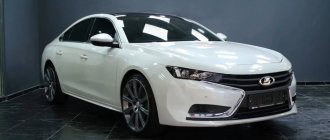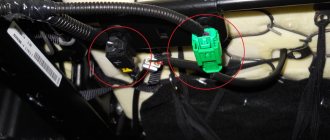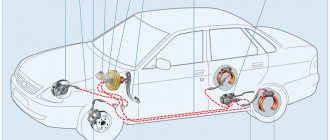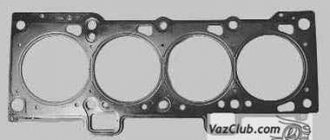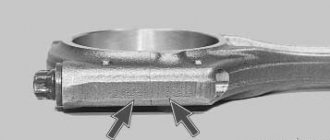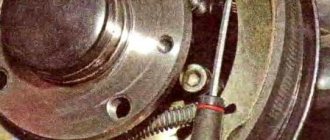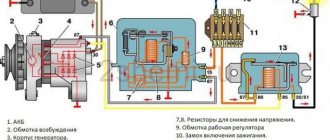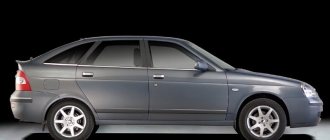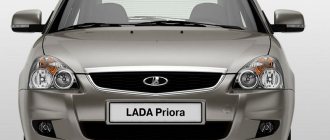Summary data for Lada Priora (before restyling 2013)
The VAZ 2170 (this is exactly the indexing that Priora received) has an improved interior compared to the “ten”, a 16-valve engine with a volume of 1596 cc. see, and a 5-speed manual transmission in all trim levels (in the first trim levels of the sedan and hatchback with an 80 hp engine, an 8-valve engine was installed). In mixed driving mode, the Priora has 100 km. it takes from 6.6 to 7.6 liters. fuel outside the city (depending on the configuration), and in the city - 9.8 liters. The new engine allows you to accelerate to 180 km/h, and to “hundreds” in 12 seconds. This property attracts the attention of fans of high-speed racing, because by working on the engine and tuning the car, you can achieve good sports performance.
Dimensions
The Lada Priora with a hatchback body has the most “modest” dimensions in its series. The length of the five-door version is only 4.24 meters, the three-door version is slightly shorter - 4.21. The height parameters are average, in comparison with the low-set sedan and the high “station wagon” - 1.43 meters.
The width is the same as other body types - 1.68 meters. Almost all versions have a clearance height of 16.8 centimeters, with the exception of the “Sport” line, where it is slightly lower.
How much does Lada Priora weigh?
The weight of the car before restyling in 2013 was as follows:
- The 3-door hatchback coupe, 5-door hatchback and sedan have a curb weight (which includes the weight of a full tank of fuel and the driver) of 1088 kg. In this case, the total weight (i.e., the maximum permissible weight of the vehicle at which it can be operated after being fully loaded) is 1578 kg;
- The station wagon, with the same curb weight, is able to take a little more cargo, and its total weight reaches 1593 kg.
Thus, the station wagon is the most load-carrying of all Priora body types.
Transmission
Initially, the hatchback came with a manual transmission. In fact, it was a strengthened version of the gearbox from the 110th Lada. Drivers immediately noted the poor quality of the mechanics, which became known for having very poor synchronizers. Often the handle simply “jumped” out of gear or the desired mode simply did not turn on.
The release lever began to knock just 3 months after purchase, and unclear shifts were observed immediately from the passenger compartment.
Subsequently, the restyled version of “2180” received updated mechanics, which worked much smoother. The sudden knocks disappeared and shifts became smooth. Afterwards, AvtoVAZ updated the gearbox and installed a robotic version, which received mixed reviews. However, it is very reliable and convenient; there are no reviews about its inoperability.
How long does a gas tank last?
With the maximum filling of the gas tank, the Lada Priora, powered by AI-95 (according to the passport!) will travel:
- 438 km in the city;
- 767 km on the highway;
- 597 km combined cycle.
However, the driving range on a full tank is given by us as a rough estimate, since depending on the configuration and modification it may vary slightly, although in all cases the volume of the gas tank is the same: 43 liters.
Body
In all versions of the Priora, the bodywork is mediocre. Drivers and experts had 2 complaints:
Susceptibility to rust. The body is made of ordinary steel, without alloying additives. For this reason, after the first winter it begins to actively rust and it will not be possible to stop this process.
Poor paintwork. Some noticed that it began to fall off in large “chips.” You will have to constantly visit the paint shop to paint over them, otherwise the corrosion process will be unstoppable.
Cargo capacity
Cargo capacity (not payload!) of the Prior varies depending on the body type. So, trunks have different volumes:
- 360 liters – for hatchback and coupe;
- 430 liters - for the sedan;
- 444 liters - for the station wagon.
As we can see, this volume is not very different from the sedan’s, so it’s a very stretch to say that the Priora station wagon was created to solve a wide range of economic problems (relative to other variants of this car). Of course, cargo capacity increases significantly if you fold the back of the rear sofa, or even better, remove the entire rear seat.
Pros and cons of a white car
Advantages of painting a Priora white hatchback car:
• Of course, a chic appearance! White color can visually increase volume. Therefore, clean and sparkling in the sun, as if from a picture, the white Priora hatchback always has an impressive and at the same time elegant appearance.
• In dry weather, dust and dirt are much less visible on it than on cars with a dark color. Pollution becomes noticeable only from a close distance, but from a distance the car appears clean. Accordingly, cleaning costs are reduced.
• White color tends to reflect sunlight. This is especially felt in the summer heat. The white Priora hatchback (photo below) heats up much less.
• It is clearly visible on the road, including at night. This most likely determines the statistics of accidents - white cars get into them much less often.
• The purer the white color of your Lada, the less susceptible it will be to fading. In case of repairs and the need for touch-up, it will be much easier to choose a shade that best matches the original one.
• Small scratches and chips are much less noticeable. This is because paint primer is usually white. Therefore, if the scratch is shallow, then it is not visible.
• White Priora hatchback lends itself very well to modernization. Tuning (pictured), which will make your car original, can be done with your own hands.
Dimensions of VAZ 2170 and other modifications of Priora
The dimensions of the car are something that needs to be taken into account when purchasing, since the dimensions of parking spaces, garages, turns or entrance arches are not always universal. The height is measured from the extreme point of the front to the extreme point of the rear bumper. The width is measured at the widest point, and the height is measured from the surface of the ground to the highest point of the roof. Roof rails and racks do not fit into the height of the body. Taking this into account, the dimensions of the Priora are as follows:
- The longest body of cars in this family is the sedan. It measures 4350 mm in length. But at the same time it is the lowest - 1420 mm. in height.
- The next longest is the station wagon, with its 4340 mm length. It is the highest in height – 1508 mm.
- The five-door hatchback and three-door coupe are the shortest - 4210 mm. at 1435 mm. in height.
In all four cases, the width of the Priora is the same - 1680 mm. Ground clearance is 165 mm, although in the Priora Sport configuration it is somewhat reduced, but this is no longer so important, since this car is no longer produced in this version.
Operational deficiencies
Like most domestic cars, Priora has a rather weak paint coating, as a result of which the body of used cars is covered with chips and scratches. However, the problem with the low quality of metal and the level of anti-corrosion treatment is much more acute. As a result, the car quickly begins to become covered with rust, showing hot spots in various places. The most susceptible to corrosion are wheel arches, doors, sills and hood.
Engine
Both gasoline engines have proven themselves well during operation and are unpretentious in maintenance. The biggest problems are caused by electronic sensors, which cannot serve as a standard for durability. Quite often the throttle valve and the gasket between the head and the cylinder block fail due to the low quality of gasoline. When it gets dirty, the car stalls and loses traction. During operation of the machine, it is necessary to pay sufficient attention to the operation of the cooling system. Quite quickly, especially in the summer, the thermostat can fail, which can lead to overheating of the engine with all the ensuing consequences. Car enthusiasts will not be pleased with the long service life of the ignition coil and fuel pump. The car has a timing belt drive and, according to the manufacturer, its service life is 200 thousand kilometers. However, do not forget that as a result of a broken belt, the valve bends and you have to do a major overhaul of the engine. Therefore, owners of LADA Priora 2008 recommend changing it along with the rollers and pump at least every 100 thousand km.
Transmission
Despite the fact that the car is equipped with no alternative to a manual transmission, this gearbox cannot serve as a standard of reliability. The main disadvantage is weak synchronizers, which, however, is typical for manual transmissions installed on all AvtoVAZ models. The main sign of their failure is a characteristic crunch, which is clearly audible when changing gears. Priora received enhanced clutch from, but the problem of the limited service life of the release bearing was never solved. The service life of the transmission can be extended by using high-quality oil and regularly changing the fluid in the box, which must be done at least once every 75 thousand kilometers.
Chassis and steering
Surely many car enthusiasts are familiar with the problems of domestic cars associated with the short service life of the suspension. However, LADA Priora in this component can compete on equal terms with most budget foreign cars presented on the secondary market. Stabilizer bushings fail most quickly. As a rule, this happens already at 10–20 thousand km. mileage Following them, the stabilizer struts will have to be changed. Steering tips and wheel bearings will last about 40 - 50 thousand km. Replacement of ball joints and support bearings will be required after a mileage of 60 - 70 thousand km. Shock absorbers, CV joints and silent blocks of front levers can last 100 - 120 thousand kilometers. The original brake pads may not survive the first 10 thousand km, so the driver will have to quickly replace them with better analogues.
Poor quality operation of the electric power steering can cause certain troubles. The main signals of such a malfunction are jerking and heaviness when turning the steering wheel. The problem can be resolved by cleaning the electrical wiring contacts of the unit.
Other faults
Both the quality of the materials used for interior decoration and the level of assembly itself deserve great criticism, as a result of which car enthusiasts will have to put up with numerous extraneous sounds throughout the entire period of operation. Moreover, every year there will be more and more of them. Additional installed sound insulation and pasting of elements with vibration-absorbing materials do not help get rid of them either. The driver will constantly have to deal with malfunctions of electrical equipment, which occur mainly due to oxidation of contacts.
Modifications of Lada Priora until 2013
VAZ 2170 Lada Priora I generation cars have the following body options: 4-door sedan, 5-door hatchback and station wagon, and 3-door coupe. Depending on the year of manufacture and configuration, engine power may vary, which looks like this.
Engine Lada Priora 2007, sedan, 1st generation
Based on the configuration, sedans before the 2013 restyling are equipped with the following engines:
- 80 “horses”: 8 valves, maximum speed 172 km/h, gasoline consumption – 7.6 liters. for every 100 km. in a mixed cycle.
- 16-valve engine with 89 hp. reaches speeds of up to 176 km/h, consuming 7.3 l/100 km. paths in a mixed cycle. As you can see, in terms of its characteristics, this engine is not much different from its “younger brother,” although it consumes a little less gasoline.
- 16-valve 98-horsepower engine: maximum speed 183 km/h, AI-95 consumption in the combined cycle – 7.2 l/100 km.
Engine Lada Priora 2008, hatchback, 1st generation
5-door hatchbacks have been produced since 2008. Depending on the configuration, they are equipped with:
- 80-horsepower 8-valve engine, delivering the same speed and fuel consumption characteristics as in the case of a sedan equipped with the same engine;
- 16-valve engine with 89 hp, which produces the same speed for a hatchback and consumes the same amount of gasoline as a sedan with the same engine;
- A 98-horsepower 16-valve engine, thanks to which the hatchback completely matches the speed and consumption characteristics of a sedan with the same power plant.
Engine Lada Priora 2008, station wagon, 1st generation
With a station wagon everything is simpler. From the very beginning of production, it had only one, but the most powerful engine at that time, producing 98 l/s, which accelerated the car to 183 km/h and consumed 7.2 liters of gasoline per 100 km. paths in a mixed cycle. Thus, despite the large cargo capacity of the station wagon, its rated speed remains the same as that of other Priors in a different body version, but with the same engine, since the curb weight is the same for all modifications. Probably, when fully loaded, the station wagon will show slightly lower speed or higher fuel consumption characteristics.
Engine Lada Priora 2010, coupe, 1st generation
Since 2010, Priora has received another modification - a three-door coupe-hatchback. Everything with him is also quite simple, because... It is equipped with a 98-horsepower 16-valve engine, giving a top speed of 183 km/h, consuming 7.4 liters of gasoline per 100 km in the combined cycle, i.e. slightly more than all other body modifications. As you can see, the station wagon and coupe do not have such a wide engine variation as the 5-door hatchback and sedan, since cars of such a body are not designed for wide sale, but for specific needs: sports and motor tourism. By the way, the creators of Priora had the idea to launch a convertible into series, but reasonably considering that it would not find its buyer, they abandoned this idea.
Those. characteristics
Lada (VAZ) 2170 (Priora) (2007(2013)) 2013 – present gg.
| Brand and modification | Body type | Volume | Power | Release |
| Lada (VAZ) 21703 (Priora) | sedan (4 doors) | 1596 cm3 | 98 hp | 03.2013 – present |
| Lada (VAZ) 21703 (Priora) | sedan (4 doors) | 1596 cm3 | 106 hp | 03.2013 – present |
| Lada (VAZ) 21713 (Priora) | station wagon (5 doors) | 1596 cm3 | 98 hp | 2013 – present |
| Lada (VAZ) 21713 (Priora) | station wagon (5 doors) | 1596 cm3 | 106 hp | 2013 – present |
| Lada (VAZ) 21723 (Priora) | hatchback (5 doors) | 1596 cm3 | 98 hp | 2013 – present |
| Lada (VAZ) 21723 (Priora) | hatchback (5 doors) | 1596 cm3 | 106 hp | 2013 – present |
| Lada (VAZ) 21728 (Priora) | hatchback (3 doors) | 1596 cm3 | 98 hp | 2013 – present |
| Lada (VAZ) 21728 (Priora) | hatchback (3 doors) | 1596 cm3 | 106 hp | 2013 – present |
Lada (VAZ) 2170 (Priora) (2007) 2007 – 2013
| Brand and modification | Body type | Volume | Power | Release |
| Lada (VAZ) 21701 (Priora) | sedan (4 doors) | 1596 cm3 | 81 hp | 04.2007 – 2013 |
| Lada (VAZ) 21702 (Priora) | sedan (4 doors) | 1596 cm3 | 89 hp | 03.2007 – 2013 |
| Lada (VAZ) 21703 (Priora) | sedan (4 doors) | 1596 cm3 | 98 hp | 04.2007 – 2013 |
| Lada (VAZ) 21713 (Priora) | station wagon (5 doors) | 1596 cm3 | 98 hp | 05.2009 – 2013 |
| Lada (VAZ) 21721 (Priora) | hatchback (5 doors) | 1596 cm3 | 81 hp | 02.2008 – 2013 |
| Lada (VAZ) 21722 (Priora) | hatchback (5 doors) | 1596 cm3 | 89 hp | 05.2009 – 2013 |
| Lada (VAZ) 21723 (Priora) | hatchback (5 doors) | 1596 cm3 | 98 hp | 02.2008 – 2013 |
| Lada (VAZ) 21728 (Priora) | hatchback (3 doors) | 1596 cm3 | 98 hp | 01.2010 – 2013 |
View technical characteristics of other Lada (VAZ) / Lada (VAZ) models
The automobile catalog contains descriptions, technical characteristics and photographs of Lada (VAZ) 2170 (Priora) / Lada (VAZ) 2170 (Priora) cars produced since 1997.
Restyling Lada Priora 2013
The 2013 restyling consisted of some changes regarding the appearance, some equipment, interior and engine. Among such changes in Prior we will name:
- A slightly modified exterior geometry, which, however, makes no sense to describe, since visually Priora before and after restyling remained almost indistinguishable in appearance;
- Replacing the radiator grille with an elongated “honeycomb”, slightly tilting the car into the now fashionable “organic” style, characterized by biological forms;
- Improved external lighting technology, thanks to which the car’s dimensions have become clearer in the dark. In particular, the area of the reflectors has been increased, LED sections for side lights and brake lights have been added, which are both brighter and more responsive when switched on;
- A dashboard that is implemented differently: instead of four “dials,” the sensor arrows were arranged in two, without compromising functionality. Purely aesthetically it looks better, but from an ergonomic point of view, a lot depends on habit;
- An increased number of pictograms flashing on the dashboard, making it easier to figure out which lighting equipment is faulty;
- An added niche in the center of the dashboard, in which the on-board computer is placed;
- Extended front seat slides, allowing tall drivers and front passengers to adjust their seat positions more flexibly;
- A box that is more spacious in depth to the right of the driver;
- A more attractive three-spoke steering wheel with an airbag under a triangular cover;
- In the “luxury” configuration – leather upholstery based on a combination of auto fabric and eco-leather;
- New door card design.
Also, since 2013, Priors have been produced in a different engine configuration, from which the 80-horsepower engine was removed, but a new 106 l/s engine was added, which, like everyone else, reaches speeds of up to 183 km/h and reduces fuel consumption to 6. 8 – 6.9 liters per hundred km. This engine is equipped with the “luxury” configurations of the Priora. Of course, such a reduction in fuel consumption is very attractive to the consumer. We can only hope that the developers will continue to work in this direction. In addition, the new engine fits well into Euro-3 and Euro-4 environmental standards, thanks to the closely located catalyst. Due to rapid heating, the catalysis of toxic substances occurs more vigorously, as a result of which a lower concentration of them enters the atmosphere.
The restyled Prior also has a drawback (compared to previous editions of this car): the carpet in the trunk is thinner than its predecessors, which is why the noise level while driving is higher. Motorists are advised to take care of additional sound insulation in the trunk. In addition, the curb weight of the car has increased (to 1185 kg), which is by as much as 100 kg. reduced its cargo capabilities, since the maximum weight remained the same - 1593 kg. for a station wagon, and 1578 kg. for other body variations.
Specifications
Below we will talk about each element of the Lada Priora separately, namely, we will consider separately the body, engine, trunk, etc.
Body
Priora was produced in several bodies. In 2007, only a sedan appeared; later, in 2008, the first hatchback and station wagon rolled off the assembly line.
Sedan 2170
This body turned out to be very nice and most popular among young people. Young people started buying Priora and subjecting it to various tunings. It became a kind of youth movement.
Station wagon 2171
This type of body is an excellent solution for family people. The station wagon is equipped with a huge trunk.
Hatchback 2172
The hatchback does not differ from the sedan in technical characteristics and the front part of the body, but is shorter by several centimeters, which is noticeable to the naked eye.
Engine
Several types of engines with different power and number of valves were installed on the Lada. The table below shows all installed engines and their characteristics.
| Model | 21126 | 21127 | 21116 |
| Number of valves | 16 | 16 | 8 |
| Power (hp) | 98 | 106 | 87 |
| Type | Petrol | Petrol | Petrol |
| Torque, Nm / rpm | 145/4000 | 148/4200 | 140/3800 |
| Number of cylinders | 4 | 4 | 4 |
| Cylinder arrangement | Row | Row | Row |
| Volume (cubic cm) | 1596 | 1596 | 1596 |
| Fuel | Gasoline AI 95 | Gasoline AI 95 | Gasoline AI 95 |
| Power type | Electronic injection | Electronic injection | Electronic injection |
| Maximum speed, km/h | 183 | 183 | 172 |
| Acceleration time to 100 km/h | 11,5 | 11,0 | 12,5 |
| Average fuel consumption per 100 km | 7,2 | 7,2 | 7,6 |
Gear box
Priora was equipped with several gearboxes depending on the configuration and year of manufacture of the car. All gearboxes are 5-speed
Gearbox with rocker
This gearbox was installed on cars from 2007 to 2013. It is a fairly reliable and unpretentious gearbox, its main “soreness” is the weak second gear, which begins to fly out over time.
Cable gearbox
Installed on cars since 2014. Received a large number of positive reviews, the position of the gears, namely the reverse gear, has changed. The vibrations transmitted to the cabin from the gearbox have been reduced.
Robotic gearbox
In 2014, luxury car models began to be equipped with a robotic gearbox. It is very reliable and unpretentious, but noticeably loses in dynamics compared to a manual transmission.
Other characteristics
| Characteristic | Sedan | Station wagon | Hatchback |
| Height, mm | 1420 | 1435 | 1508 |
| Width, mm | 1680 | 1680 | 1680 |
| Length, mm | 4350 | 4340 | 4210 |
| Wheelbase, mm | 2492 | 2492 | 2492 |
| Weight, kg | 1163 | 1163 | 1088 |
| Number of seats | 5 | 5 | 5 |
| Number of doors | 5 | 5 | 5 |
| Drive unit | front | front | front |
| Wheels | 185/65 R14 | 185/65 R14 | 185/65 R14 |
| Tank capacity, l | 43 | 43 | 43 |
| Trunk volume, l | 430 | 444/777 (with rear seats folded) | 360/705 (with rear seats folded) |
Configurations of Lada Priora VAZ 2170 and other modifications
VAZ 2170 is known in the following configurations:
- “Standard” is the most budget package. It lacks: audio radio, speakers, air conditioning, rear headrests, immobilizer, central locking, heated front seats, electric drive and heated exterior mirrors, fog lights, remote trunk release. The front windows are electric, the rear windows are mechanical. The engine is 81 hp, which has been discontinued since 2013, and at the moment there are no longer orders for this configuration;
- “Norma”, which is equipped with an 87-, and after restyling - only a 98- and 106-power engine. Available: audio preparation, on-board computer, electric heating and electric drive of exterior mirrors, immobilizer, anti-theft alarm and all the elements of the “standard” equipment plus some new equipment. This configuration is in greatest demand due to its price niche. When you need a car “yesterday”, you have to buy what you have enough money for now, and everyone else has to retrofit the car in the process.
- "Norma+". In fact, this is the same standard for which one or more items of equipment are set: air conditioning, audio radio with speakers, ABS + BAS, child seat mounts, heated front seats and windshield;
- “Lux” is the most rich in functionality. It has everything that the “norm+” has, and in addition: side airbags, an airbag for the front passenger, rear and front electric windows, a navigator, a multimedia system, cruise control, parking sensors, fog lights, a rain sensor, a climate system , alloy wheels, heated front seats;
- “Sport” is a special package that increases the “sports” component. This is an aerodynamic body kit: a pronounced bumper with a spoiler, side sills, a diffuser rear bumper, and a wing on the trunk lid. The wheels with narrow profile tires are also different. Ground clearance, curb weight (up to 1080 kg) and maximum weight (up to 1500 kg) have been reduced. The interior has also been transformed: side supports have been added along the edges of the seats with red stitched seams, carbon fiber inserts, and a leather steering wheel. Air conditioning, radio, and a full set of electric windows are included. However, the production of sports Prioras was limited and today they are discontinued, although they can be found here and there on the highway, and most often these are Priora coupes.
Of course, this is not a complete, but only an indicative overview of the configurations of the Lada Priora, which is hardly possible to present in its entirety within the confines of one article. In addition, the equipment also differs somewhat depending on the body type. For example:
- Prior station wagons have roof rails, brackets on the wheel arches of the trunk, for which cargo can be strapped;
- For the coupe body, folding backrests and a reinforced frame of the front seats have been developed.
Types of correctors
Car owners often wonder what a headlight range control is and whether they can install it themselves. Depending on the device, there are several types of systems:
- electromechanical;
- hydromechanical;
- mechanical;
- automatic.
Automatic technology is the most expensive and effective. Such a system reads the body position data and independently adjusts the light beam. Other types are controlled manually using a washer or wheel located in the cabin.
Electromechanical
The electric headlight corrector allows you to adjust the angle of light from the interior. The driver independently selects the position of the washer depending on the load on the car.
The system does not have additional sensors on the vehicle's levers, so if the angle is chosen incorrectly, the light may be adjusted incorrectly. In this case, the low beam lamps will dazzle another vehicle when driving in the dark.
In the electric corrector, the motors change the position of the rod depending on the selected key indication in the cabin.
Components:
- electrical control element;
- tilt angle regulator;
- motors.
Hydromechanical
Hydrocorrector headlights are rare nowadays. A handle is installed in the cabin, which is directly connected to lines filled with liquid. When the lever is turned, pressure appears and is transmitted to the hydraulic pistons. Next, the force is transmitted to the rod, and parts of the reflector body are set in motion.
The system is fully controlled by the driver from inside the cabin. In winter, the liquid freezes and becomes noticeably thicker. It takes more effort to control the rod that affects the angle of the light.
The lines are constantly under pressure and eventually fail. The channels begin to leak, and the system does not gain the required traction when turning the knob.
If you choose the wrong angle, you may be exposed to light and dazzle other road users.
Mechanical
A mechanical corrector with cables that move the rod to adjust the angle of the reflector in the headlight was installed only on older cars. The system turned out to be unreliable and often failed after water got into the cable jacket. This effect leads to souring of the device.
A manual mechanical corrector should be used at least 2-3 times a month and the system should be periodically lubricated with oil. In winter, the system often soured and did not allow adjusting the headlight beam angle. Full lubrication of the cables helped restore functionality.
The corrector consists of the following components:
- power cables;
- control handle;
- gearbox with rod.
Currently, this type of corrector, which requires constant attention, is not used due to the expensive maintenance of the system.
Auto
Auto-corrector of headlights is most accurate in selecting the angle of light. The option is installed only in cars with xenon lamps and provides the best visibility at night.
There are no additional adjustment keys installed in the cabin; the system does everything independently in automatic mode.
The service life of the option is 10-15 years depending on operating conditions. Only the headlight range control sensor, which is installed on the car's arm and transmits a signal to the unit, may require repair.
Also among the components that require special attention is the chassis position linkage. Load control parts are installed from 1 to 3 depending on the complexity of the chassis. Over time, the moving balls sour and break off under load. To prevent breakdowns, it is necessary to lubricate the ball joints with copper grease every 40-50 thousand kilometers. This is not regulated in the vehicle operating literature, but it will help preserve the corrector components and avoid unpleasant incidents.
